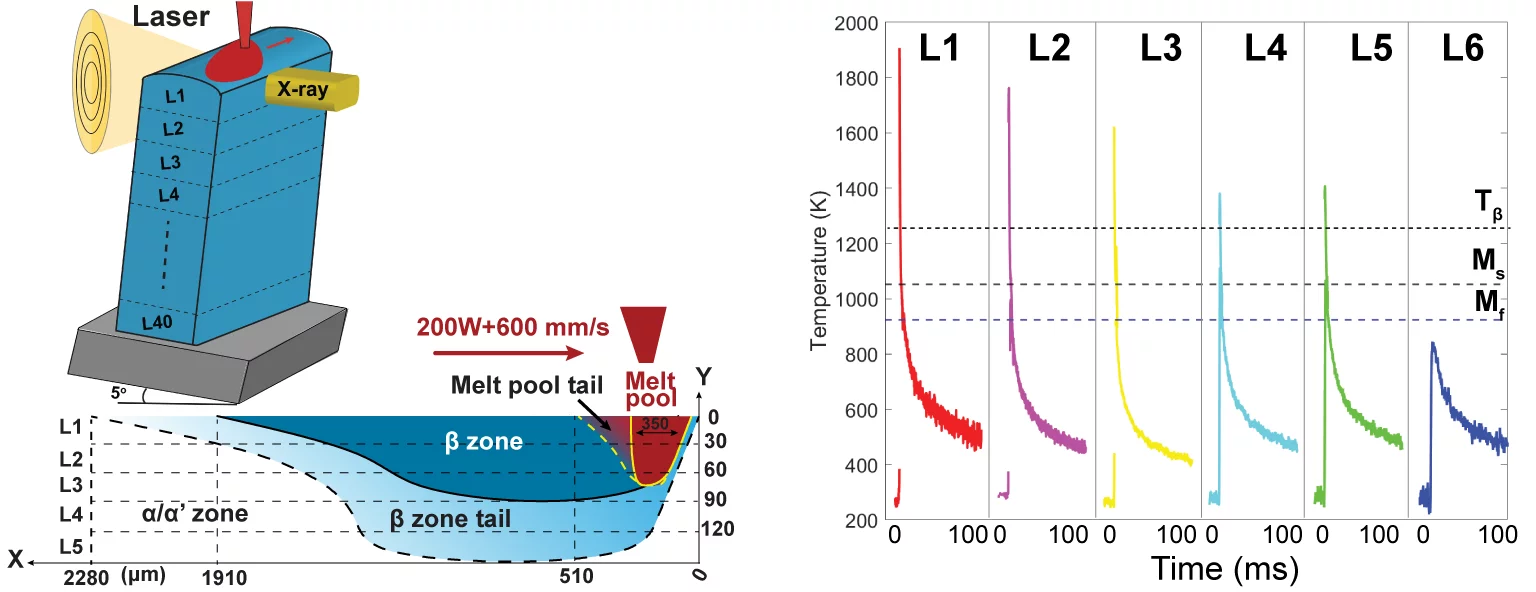High-speed in situ X-ray diffraction is used to measure temperature profiles and cooling rates during 3D printing of a Ti-6Al-4V single-track wall. Based on the temporal evolution of the various crystallographic phases, the dimensions of the melt pool and the high-temperature β zone surrounding the melt pool are estimated. Such measurements are crucial to validate finite-element models of the printing process.
During past years, several in situ synchrotron X-ray diffraction and imaging experiments have been performed to study the microstructure evolution during metal 3D printing. The melt pool dynamics can be studied in detail by fast radiography experiments. The evolution of the crystallographic phases, stress and temperature has been investigated by in situ X-ray diffraction.
However, the direct measurement of temperature data at different distances from the laser processing surface is rather limited, especially at regions close to melt pool. In this study, we propose a method to obtain the temperature profiles below the processing plane during L-PBF by using high-speed in situ X-ray diffraction in transmission mode while the laser re-scans the top of a previously printed thin wall. We apply this method to Ti-6Al-4V, a representative alloy widely used in L-PBF process. The phase evolution, temperature profile, and cooling rates were measured for different layers every 30 μm, corresponding to the nominal layer thickness of printed the wall, with a high time resolution of 50 µs. The temperature profiles and phase evolution as a function of time were used to estimate the dimensions of the melt pool and the β zone surrounding the melt pool. We advocate that the data obtained from in situ measurements in transmission mode on a thin wall combined with in situ measurements in reflection mode on a bulk sample allows full verification and validation of finite element L-PBF models.
Part of the research was performed at the MicroXAS beamline at the Swiss Light Source using a miniaturized laser powder bed fusion device.
Contact
Dr. Steven Van Petegem
Structure and Mechanics of Advanced Materials
Photon Science Division
Paul Scherrer Institute
Forschungsstrasse 111, 5232 Villigen PSI, Switzerland
Telephone: +41 56 310 2537
E-mail: steven.vanpetegem@psi.ch
Original publication
A quantitative study of thermal cycling along the build direction of Ti-6Al-4V produced by laser powder bed fusion
Ming Chen, Marco Simonelli, Steven Van Petegem*, Yau Yau Tse, Cynthia Sin Ting Chang, Malgorzata Grazyna Makowska, Dario Ferreira Sanchez, Helena Moens-Van Swygenhoven
Materials & Design 255 (2023) 111458
DOI: 10.1016/j.matdes.2022.111458


